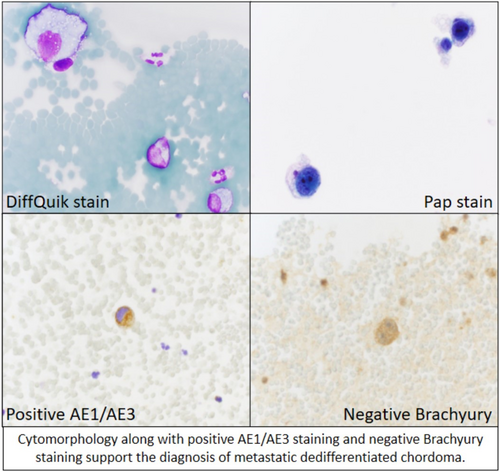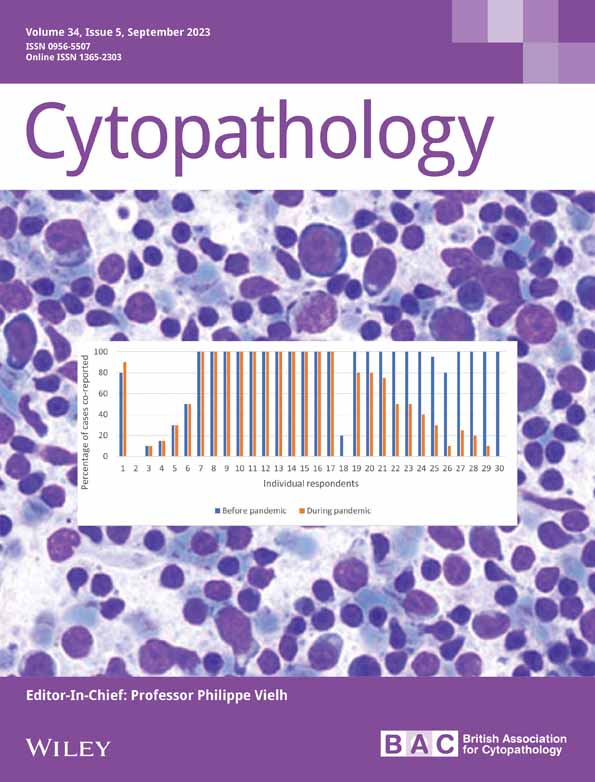Cytomorphology of a unique case of dedifferentiated chordoma involving a pleural effusion specimen
Corresponding Author
Agha Wajdan Baqir
Department of Pathology, University of Pittsburgh Medical Center, Pittsburgh, Pennsylvania, USA
Correspondence
Agha Wajdan Baqir, Department of Pathology, University of Pittsburgh Medical Center, Pittsburgh, PA, USA.
Email: [email protected]
Search for more papers by this authorSamer N. Khader
Department of Pathology, University of Pittsburgh Medical Center, Pittsburgh, Pennsylvania, USA
Search for more papers by this authorRana Naous
Department of Pathology, University of Pittsburgh Medical Center, Pittsburgh, Pennsylvania, USA
Search for more papers by this authorCorresponding Author
Agha Wajdan Baqir
Department of Pathology, University of Pittsburgh Medical Center, Pittsburgh, Pennsylvania, USA
Correspondence
Agha Wajdan Baqir, Department of Pathology, University of Pittsburgh Medical Center, Pittsburgh, PA, USA.
Email: [email protected]
Search for more papers by this authorSamer N. Khader
Department of Pathology, University of Pittsburgh Medical Center, Pittsburgh, Pennsylvania, USA
Search for more papers by this authorRana Naous
Department of Pathology, University of Pittsburgh Medical Center, Pittsburgh, Pennsylvania, USA
Search for more papers by this authorGraphical Abstract
Open Research
DATA AVAILABILITY STATEMENT
The data that support the findings of this study are available from the corresponding author upon reasonable request.
REFERENCES
- 1 WHO Classification of Tumours Editorial Board. Soft Tissue and Bone Tumours [Internet]. Vol 3. 5th ed. International Agency for Research on Cancer; 2020. WHO classification of tumours series. Accessed December 12, 2022. https://tumourclassification.iarc.who.int/chapters/33
- 2Debernardi L. Cordoma sarcomatoso del sacro contributo alla conoscenza istologica e clinica dei tumori di origine cordale [Sarcomatous chordoma of the sacrum: contribution to histological and clinical knowledge of tumors of chordal origin]. Arch Sci Med (Torino). 1913; 37: 404-442.
- 3Das P, Soni P, Jones J, et al. Descriptive epidemiology of chordomas in the United States. J Neurooncol. 2020; 148(1): 173-178.
- 4Hung Y, Diaz-Perez JA, Cote GM, et al. Dedifferentiated Chordoma: clinicopathologic and Molecular Characteristics With Integrative Analysis. Am J Surg Pathol. 2020; 44(9): 1213-1223.
- 5McMaster ML, Goldstein AM, Bromley CM, Ishibe N, Parry DM. Chordoma: incidence and survival patterns in the United States, 1973-1995. Cancer Causes Control. 2001; 12(1): 1-11.
- 6Mukherjee D, Chaichana KL, Gokaslan ZL, Aaronson O, Cheng JS, McGirt MJ. Survival of patients with malignant primary osseous spinal neoplasms: results from the surveillance, epidemiology, and end results (SEER) database from 1973 to 2003. J Neurosurg Spine. 2011; 14(2): 143-150.
- 7Vujovic S, Henderson S, Presneau N, et al. Brachyury, a crucial regulator of notochordal development, is a novel biomarker for chordomas. J Pathol. 2006; 209(2): 157-165.
- 8Miettinen M, Wang Z, Lasota J, Heery C, Schlom J, Palena C. Nuclear Brachyury expression is consistent in Chordoma, common in germ cell tumors and small cell carcinomas, and rare in other carcinomas and sarcomas: an Immunohistochemical study of 5229 cases. Am J Surg Pathol. 2015; 39(10): 1305-1312.
- 9Asioli S, Zoli M, Guaraldi F, et al. Peculiar pathological, radiological and clinical features of skull-base de-differentiated chordomas. Results from a referral Centre case-series and literature review. Histopathology. 2020; 76(5): 731-739.
- 10Bergh P, Kindblom LG, Gunterberg B, Remotti F, Ryd W, Meis-Kindblom JM. Prognostic factors in chordoma of the sacrum and mobile spine: a study of 39 patients. Cancer. 2000; 88(9): 2122-2134.
10.1002/(SICI)1097-0142(20000501)88:9<2122::AID-CNCR19>3.0.CO;2-1 CAS PubMed Web of Science® Google Scholar
- 11Cote GM, He J, Choy E. Next-generation sequencing for patients with sarcoma: a single center experience. Oncologist. 2018; 23(2): 234-242.
- 12Batista KMP, Reyes KYA, Lopez FP, et al. Immunophenotypic features of dedifferentiated skull base chordoma: an insight into the intratumoural heterogeneity. Contemp Oncol (Pozn). 2017; 21(4): 267-273.
- 13Davidson B, Nielsen S, Christensen J, et al. The role of desmin and N-cadherin in effusion cytology: a comparative study using established markers of mesothelial and epithelial cells. Am J Surg Pathol. 2001; 25(11): 1405-1412.
- 14Safadi RA, Bader DH, Abdullah NI, Sughayer MA. Immunohistochemical expression of keratins 6, 7, 8, 14, 16, 18, 19, and MNF-116 pancytokeratin in primary and metastatic melanoma of the head and neck. Oral Surg Oral Med Oral Pathol Oral Radiol. 2016; 121(5): 510-519.
- 15Gleason BC, Fletcher CD. Myoepithelial carcinoma of soft tissue in children: an aggressive neoplasm analyzed in a series of 29 cases. Am J Surg Pathol. 2007; 31(12): 1813-1824.
- 16Hornick JL, Dal Cin P, Fletcher CD. Loss of INI1 expression is characteristic of both conventional and proximal-type epithelioid sarcoma. Am J Surg Pathol. 2009; 33(4): 542-550.
- 17Antonescu CR, Zhang L, Chang NE, et al. EWSR1-POU5F1 fusion in soft tissue myoepithelial tumors. A molecular analysis of sixty-six cases, including soft tissue, bone, and visceral lesions, showing common involvement of the EWSR1 gene. Genes Chromosomes Cancer. 2010; 49(12): 1114-1124.





